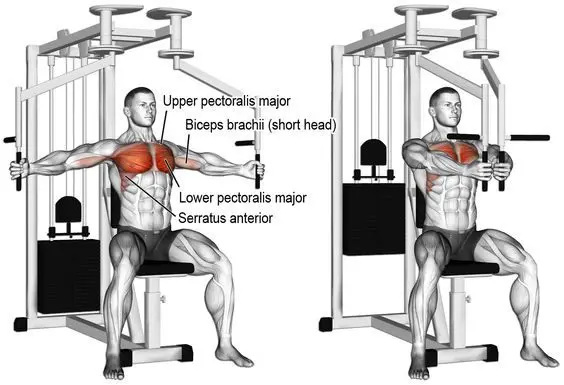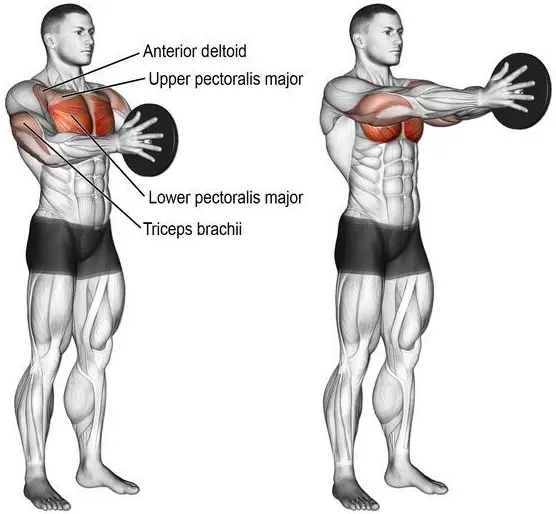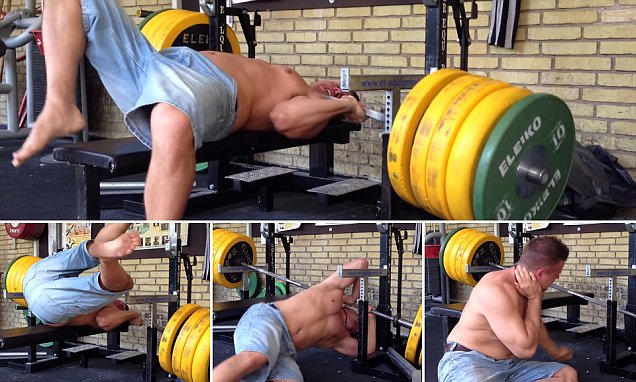The pec deck is a very popular exercise. That’s because it works. Very few other exercises isolate your pecs as effectively. The pec deck is also a great way to train your chest to failure. After all, if you can’t complete a rep, all you need to do is open your arms and lower the weights back down. There are no heavy bars to get pinned under.
You can use the pec deck at the start of a pre-exhaust superset or toward the end of your workout to fully fatigue your chest muscles. In fact, it slots really well into almost any part of your chest workout – it’s a versatile exercise.
But, as good as the pec deck is, it locks you into a very prescriptive movement pattern and range of motion. Every rep is identical, and that means your body will soon get used to it. You’ve probably noticed how the pec deck doesn’t make your chest sore like it used to.
If you keep on doing set after set of pec deck, your workouts will start to lose some of their effectiveness. Leave your program unchanged for too long, and your progress will eventually plateau.
Avoid training ruts by changing your workout every 6-8 weeks. To help you with this, here are 12 pec deck alternatives to try.
Level Up Your Fitness: Join our 💪 strong community in Fitness Volt Newsletter. Get daily inspiration, expert-backed workouts, nutrition tips, the latest in strength sports, and the support you need to reach your goals. Subscribe for free!
Pec Deck Anatomy
Leg extensions are an alternative to pec decks, but they’re not a good one! To be a valid alternative, the exercise in question needs to work the same key muscles, albeit using a different movement or training apparatus.

The main muscles involved in the pec deck are:
Pectoralis major – known as your pecs for short, this is your primary chest muscle. Located on the front of your upper torso, the pecs are responsible for horizontal flexion and medial rotation of your shoulders. The pecs are the agonist when using a pec deck, which means it is the prime mover and why most people do this exercise.
Pectoralis minor – pec minor is a thin, flat muscle that lies underneath the pec major. It assists your pec major during the pec deck and also prevents your shoulders from lifting.
Anterior deltoids – located on the front of your shoulders, the anterior deltoids work with your pecs to flex your shoulder joint.
Serratus anterior – the serratus anterior lies along the sides of your chest, above your first eight ribs. Its primary function is holding the scapula or shoulder blades flat against your torso. When well-developed, and if you are lean enough to see it, this muscle looks like the edge of a serrated knife, which is how it gets its name.
Top Peck Deck Alternatives and Substitutes
Whether you are bored of using the pec deck or just don’t have access to one, these are the best exercises to do instead!
1. Cable Crossover
Cable crossovers isolate your chest much like the pec deck. Using a cable crossover machine, you can target your upper, middle, or lower pecs depending on the angle of your arms. You’ll need to use your core to stabilize your spine during cable crossovers, and that means you won’t be able to go as heavy as you can with pec decks. Negate this drawback by moving slowly and smoothly and really squeezing your pecs at the midpoint of each rep.
Learn more about cable crossovers in our detailed guide.
2. Cable Supine Fly
If you prefer to work your pecs lying on a bench, this exercise is a good option. Using cables means your pecs are under almost constant tension, which should produce a great pump. While setting up this exercise can be a little awkward, your efforts will be rewarded.
How to do it:
- Please a bench in the middle of a cable crossover machine. Hold a handle in each hand and lie on the bench. Extend your arms so they’re vertical and your elbows are slightly bent but rigid.
- Open your arms and lower the handles down toward the floor, taking care not to hyperextend your shoulders.
- Squeeze your arms back up and bring the handles together over your chest.
- That’s one rep; keep going!
- Do this exercise using an incline bench for variation.
3. Dumbbell Fly
Before the pec deck machine was invented, if you wanted to isolate your pecs, you probably did dumbbell flyes. While this exercise is decidedly low-tech and old-school, it’s still a good pec exercise and ideal if you don’t have access to resistance training machines.
How to do it:
- Lie on a bench with a dumbbell in each hand. Press the weights up and hold them over your chest, palms facing inward. Your elbows should be slightly bent but rigid.
- Open your arms and lower the weights out and down to form a T-shape. Take care not to hyperextend your shoulders, but do get a good stretch in your pecs.
- Squeeze the weights back up and together and repeat.
- You can do dumbbell flyes on a decline, flat, or incline bench to hit different parts of your chest.
Learn more about dumbbell flyes here.
4. Wide Grip Bench Press
All bench press variations work your chest, but the wide-grip variation is one of the best for emphasizing your pecs. A wide grip increases the range of motion at your shoulder, producing a more significant pec stretch at the bottom of each rep. On the downside, wide grip bench presses can be hard on your joints, so don’t go too heavy. Experiment to find the ideal grip width that allows you to work your pecs without bothering your shoulders.
Level Up Your Fitness: Join our 💪 strong community in Fitness Volt Newsletter. Get daily inspiration, expert-backed workouts, nutrition tips, the latest in strength sports, and the support you need to reach your goals. Subscribe for free!
Discover more about wide grip bench presses here.
5. Machine Fly
Machine flyes are a lot like the pec deck. However, with this exercise, you hold handles in your hands instead of pressing your arms against pads. Because the handles are hinged, you can modify this exercise according to your limb length. As a result, some lifters find machine flyes more comfortable than the pec deck machine.
Find out how to do machine flyes here.
6. Floor Slider Chest Fly
No pec deck, pec fly machine, or dumbbells? Don’t worry; you can still work your chest in a similar fashion using slider pads. If you don’t have slider pads, just use a couple of towels and a smooth floor.
How to do it:
- Adopt the push-up position with your arms and legs straight and hands shoulder-width apart. Place your hands on the sliders. Brace your abs.
- Keeping your body straight and arms slightly bent but rigid, open your arms and slide your hands apart, lowering your chest toward the floor.
- Squeeze your hands back together and repeat.
- Make this exercise easier by doing it on your knees or harder by wearing a weighted vest.
7. TRX Fly
TRXs and other suspension trainers are incredibly versatile. They add an element of instability to most bodyweight exercises and allow you to use a larger range of motion, both of which make any exercise more challenging. There are also several specific suspension trainer exercises that are unique to this training tool. Pump up your pecs with TRX flyes.
How to do it:
- Holding the handles of your suspension trainer, stand with your back to the anchor point, extends your arms out to form a T-shape, and adopt a staggered stance. Lean forward to tension your pecs. Brace your abs.
- Squeeze your arms together to push your body backward. Keep your arms slightly bent but rigid throughout.
- Return to the starting position and repeat.
- The further you move your feet back, and the more you lean forward, the more weight will be on your arms, and the more challenging this exercise becomes. Adjust your feet to select the required amount of resistance.
8. Svend Press

Who was Svend? We don’t know! But this unusual pec exercise was named after him. The Svend press overloads your muscles using tension as opposed to weight. Press your arms inward as hard as you can to get the most from this movement. This exercise works best when done for moderate to high reps, i.e., 12 to 20.
Find out how to do the Svend press here.
9. Resistance Band Fly
Resistance bands are light, portable, and easy on your joints. They’re ideal for home workouts and, with a bit of creativity, you can use bands to replicate almost any free-weight or machine exercise. Resistance band flyes are a decent alternative to the pec.
How to do it:
- Attach your bands to shoulder-high anchors. Take a band in each hand and stand with your back to the anchors. Extend your arms, and then keep your elbows slightly rigid. Adopt a staggered stance for balance. Brace your abs.
- Bring your hands forward, so they meet in front of you.
- Open your arms and repeat.
- You can target your upper, middle, or lower pecs depending on the angle of your arms.
10. Gironda Neck Press
Vince Gironda was known as the Iron Guru. This Hollywood-based trainer worked with many film and physique stars in the 1960s, 70s, and early 80s and was known for using unusual exercises to target and isolate specific muscles. The Gironda neck press, also known as the guillotine press, was his bench press variation designed to increase pec activation. Be warned; this exercise can result in serious injury if you are unable to complete a rep. Only do neck presses with a spotter on hand.
Learn how to do this exercise here.
11. Medicine Ball Push-up
Push-ups are an effective if sometimes underrated pec exercise. Putting your hands on a medicine ball increases pec activation and emphasizes the inner part of your chest, which is what makes it a good alternative to the pec deck.
How to do it:
- Place your medicine ball on the floor. Put your hands on the ball so they’re on either side of the apex. Squeeze your hands inward. Walk your feet out and back into the push-up position and brace your abs.
- Bend your arms and lower your chest to the ball. Keep pressing your hands inward.
- Extend your arms and repeat.
- Make this exercise easier by resting on your knees or harder by elevating your feet.
12. Close Grip Dumbbell Press
Also known as the dumbbell squeeze press, this exercise increases pec activation during dumbbell bench presses. Most exercisers find that they don’t need to go too heavy during this exercise to get a good pec workout. This makes it useful for home exercisers who may not have access to heavy dumbbells and lifters with elbow and shoulder pain who need a more joint-friendly workout.
Learn how to do close grip dumbbell bench presses here.
More Alternative Exercises:
- Pec Deck Guide
- Best Bench Press Alternatives
- Best Back Extension Alternatives
- Best Cable Crossover Alternatives
- Triceps Pushdown Alternatives
- Power Clean Alternatives
- Best Face Pull Alternatives
Wrapping Up
The pec deck is a popular exercise, but it’s not essential for building a great chest. In fact, it’s just one of many exercises that you can include in your workouts. Like any exercise, if you use the peck deck too often, your body will adapt, and you won’t get such good results.
So, use but don’t abuse the pec deck. Maintain workout productivity by replacing the pec deck from time to time with any of the 12 alternatives in this article. Each one is every bit as effective but is different enough to ensure that your pecs keep getting stronger and more muscular.
Interested in measuring your progress? Check out our strength standards for Bench Press, Push Ups, Face Pull, and more.









